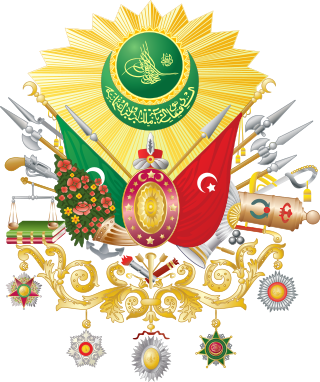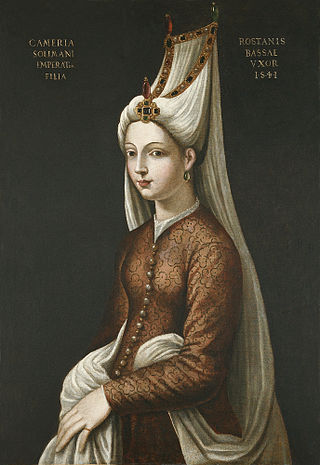Related Research Articles

Bayezid I, also known as Bayezid the Thunderbolt, was the sultan of the Ottoman Empire from 1389 to 1402. He adopted the title of Sultan-i Rûm, Rûm being the Arabic name for the Eastern Roman Empire. In 1394, Bayezid unsuccessfully besieged Constantinople. He defeated the Crusaders at the Battle of Nicopolis in what is now Bulgaria in 1396. He was later defeated and captured by Timur at the Battle of Ankara in 1402 and died in captivity in March 1403, which triggered the Ottoman Interregnum.

Mehmed II, commonly known as Mehmed the Conqueror, was twice the sultan of the Ottoman Empire from August 1444 to September 1446 and then later from February 1451 to May 1481.

Mehmed III was the sultan of the Ottoman Empire from 1595 until his death in 1603. Mehmed was known for ordering the execution of his brothers and leading the army in the Long Turkish war, during which the Ottoman army was victorious at the decisive Battle of Keresztes. This victory was however undermined by some military losses such as in Gyor and Nikopol. He also ordered the successful quelling of the Jelali rebellions. The sultan also communicated with the court of Elizabeth I on the grounds of stronger commercial relations and in the hopes of England to ally with the Ottomans against the Spanish.

Ertuğrul or Ertuğrul Ghazi was a 13th-century bey, who was the father of Osman I. Little is known about Ertuğrul's life. According to Ottoman tradition, he was the son of Suleyman Shah, the leader of the Kayı tribe of the Oghuz Turks. These Turkomans fled from western Central Asia to Anatolia to escape the Mongol conquests, but he may instead have been the son of Gündüz Alp. According to this legend, after the death of his father, Ertuğrul and his followers entered the service of the Sultanate of Rum, for which he was rewarded with dominion over the town of Söğüt on the frontier with the Byzantine Empire. This set off the chain of events that would ultimately lead to the founding of the Ottoman Empire.

The historiography of the Ottoman Empire refers to the studies, sources, critical methods and interpretations used by scholars to develop a history of the Ottoman Dynasty's empire.

The Köprülü era was a period in which the Ottoman Empire's politics were frequently dominated by a series of grand viziers from the Köprülü family. The Köprülü era is sometimes more narrowly defined as the period from 1656 to 1683, as it was during those years that members of the family held the office of grand vizier uninterruptedly, while for the remainder of the period they occupied it only sporadically.
Nakşidil Sultan was a consort of Sultan Abdul Hamid I, and Valide Sultan to their son Mahmud II, Sultan of the Ottoman Empire.

Dervish Ahmed, better known by his pen name Âşıki or his family name Aşıkpaşazade, was an Ottoman historian and a prominent representative of the early Ottoman historiography. He was a descendant of mystic poet dervish Aşık Pasha (1272–1333). He was born in the region of Amasya and studied in various Anatolian towns before going to Hajj and stayed some time in Egypt. He later took part in various Ottoman campaigns, such as the Battle of Kosovo (1448),the Fall of Constantinople and witnessed the circumcision festivities of Mustafa and Bayezid II, the sons of Mehmed the Conqueror. Later in his life he started to write his famous history work Tevārīḫ-i Āl-i ʿOsmān.
Köse Mihal accompanied Osman I in his ascent to power as a bey and founder of the Ottoman Empire. He is considered to be the first significant Byzantine renegade and convert to Islam to enter Ottoman service.

Mihrimah Sultan was an Ottoman princess, the daughter of Ottoman Sultan Suleiman the Magnificent and his wife, Hürrem Sultan. She was the most powerful imperial princess in Ottoman history according to historian Mustafa Selaniki who described her as the greatest and most respected princess and a prominent figure in the so-called Sultanate of Women.

Pavlos Karolidis or Karolides was a Greek historian who lived in the late 19th and early 20th centuries.
Tursun Beg was an Ottoman bureaucrat and historian who wrote a chronicle dedicated to Mehmed II.
Şükrullah was a 15th-century Ottoman historian and diplomat. He was one of the earliest Ottoman historians.
Selçukname is an informal term used for any of a number of medieval chronicles about Seljuk history written by different authors, mostly in Persian. It is also used for the 15th century Ottoman chronicle Tevârih-i Âl-i Selçuk. The Ottoman chronicle, written by Yazıcıoğlu Ali in Ottoman Turkish, is the only official history of the Imperial Court from Murad II's reign and serves to establish a narrative of the Ottoman dynasty's claim of descent through the Seljuks.

The Ottoman decline thesis or Ottoman decline paradigm is an obsolete historical narrative which once played a dominant role in the study of the history of the Ottoman Empire. According to the decline thesis, following a golden age associated with the reign of Sultan Suleiman the Magnificent, the empire gradually entered into a period of all-encompassing stagnation and decline from which it was never able to recover, lasting until the dissolution of the Ottoman Empire in 1923. This thesis was used throughout most of the twentieth century as the basis of both Western and Republican Turkish understanding of Ottoman history. However, by 1978, historians had begun to reexamine the fundamental assumptions of the decline thesis.

The Transformation of the Ottoman Empire, also known as the Era of Transformation, constitutes a period in the history of the Ottoman Empire from c. 1550 to c. 1700, spanning roughly from the end of the reign of Suleiman the Magnificent to the Treaty of Karlowitz at the conclusion of the War of the Holy League. This period was characterized by numerous dramatic political, social, and economic changes, which resulted in the empire shifting from an expansionist, patrimonial state into a bureaucratic empire based on an ideology of upholding justice and acting as the protector of Sunni Islam. These changes were in large part prompted by a series of political and economic crises in the late 16th and early 17th centuries, resulting from inflation, warfare, and political factionalism. Yet despite these crises the empire remained strong both politically and economically, and continued to adapt to the challenges of a changing world. The 17th century was once characterized as a period of decline for the Ottomans, but since the 1980s historians of the Ottoman Empire have increasingly rejected that characterization, identifying it instead as a period of crisis, adaptation, and transformation.
Shlomo Yellin was a Jewish lawyer and Ottoman nationalist who was born in the Old City of Ottoman Jerusalem.

Gündüz Alp was the likely father of Ertuğrul and grandfather of Osman I, the founder of the Ottoman Dynasty. According to some sources, the name of one of the sons of Ertuğrul was also Gündüz Alp, and thus the brother of Osman I. Ottoman histories, written around the 15th century, differ in details about Osman I's ancestry.
Amy Singer is a Professor of Ottoman and Islamic History at Brandeis University. Her major research areas are agrarian relations, philanthropy, and the city of Edirne.
Manuel Bochalis was an Albanian military commander in the service of the Despotate of the Morea and the Republic of Venice.
References
- 1 2 3 Isom-Verhaaren & Schull 2016, p. 66.
- ↑ Woodhead 1995, p. 7.
- ↑ Woodhead 1995, pp. 7–8.
